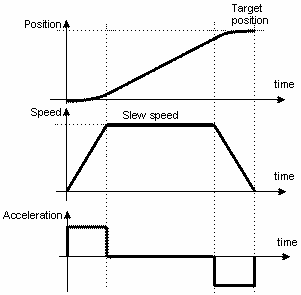In the trapezoidal position profile, the load/motor is controlled in position. The built-in reference generator computes a position profile with a trapezoidal shape of the speed, due to a limited acceleration. You specify either a position to reach in absolute mode or a position increment in relative mode, plus the slew (maximum travel) speed and the acceleration/deceleration rate. In relative mode, the position to reach can be computed in 2 ways: standard (default) or additive. In standard relative mode, the position to reach is computed by adding the position increment to the instantaneous position in the moment when the command is executed. In the additive relative mode, the position to reach is computed by adding the position increment to the previous position to reach, independently of the moment when the command was issued. The additive relative mode is activated by setting ACR.11 = 1.
Remarks:
| • | The motion mode and its parameters become effective after the execution of the update command UPD |
| • | The additive relative mode is automatically disabled after an the update command UPD, which sets ACR.11 = 0 restoring the standard relative mode |
You can switch at any moment, including during motion, from another motion mode to the trapezoidal position profile. This operation is possible due to the target update mode 0 TUM0 which is automatically activated when a new motion mode is set.
During motion, you can change on the fly the position command, the slew speed and the acceleration/deceleration rate. These changes become effective at next update command UPD.

Position profile with trapezoidal shape of the speed
Once set, the motion parameters are memorized. If you intend to use the same values as previously defined for the acceleration rate, the slew speed, the position increment or the position to reach, you don’t need to set their values again in the following trapezoidal profiles.
Remark: The additive mode for relative positioning is not memorized and must be set each time a new additive relative move is set.
See also:
Trapezoidal Position Profiles – Related TML Instruction and Data
Trapezoidal Position Profiles – On the fly change of the motion parameters
Trapezoidal Position Profiles – Automatic elimination of round-off errors